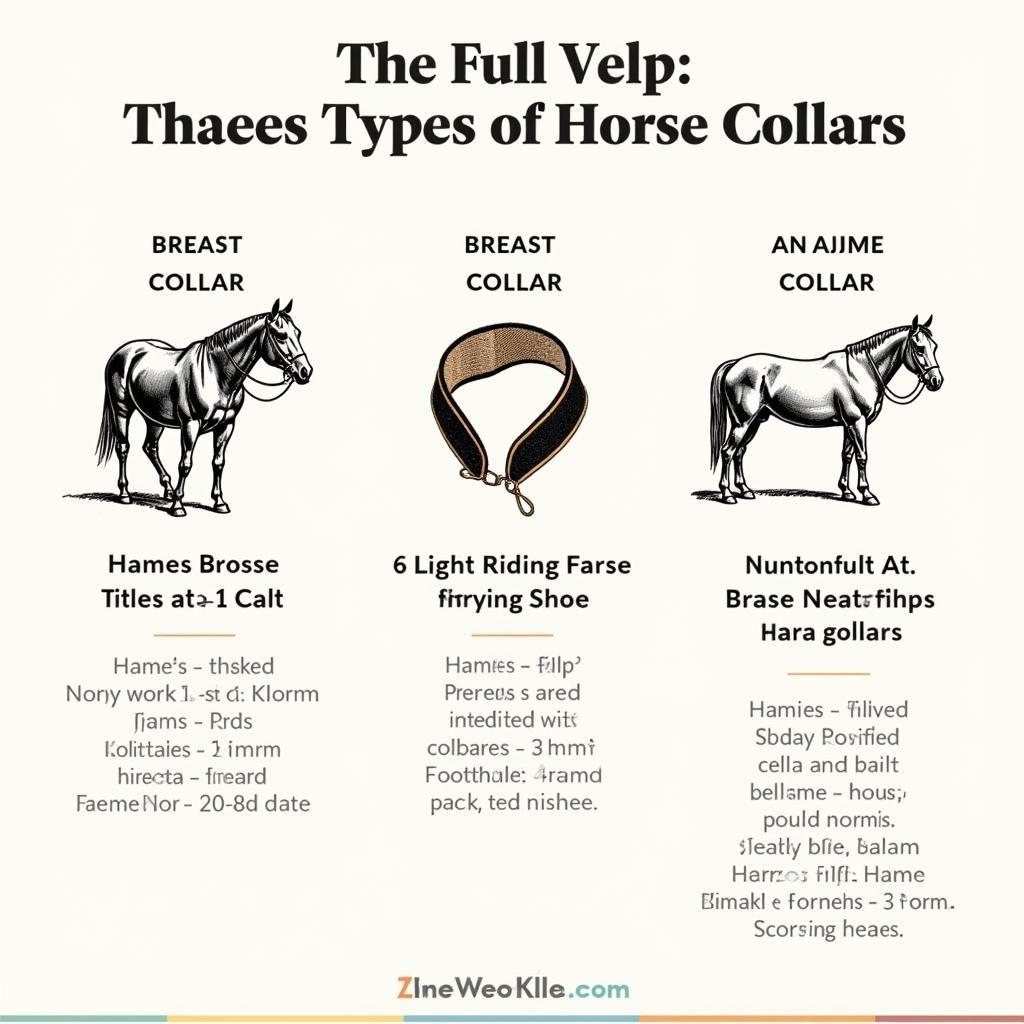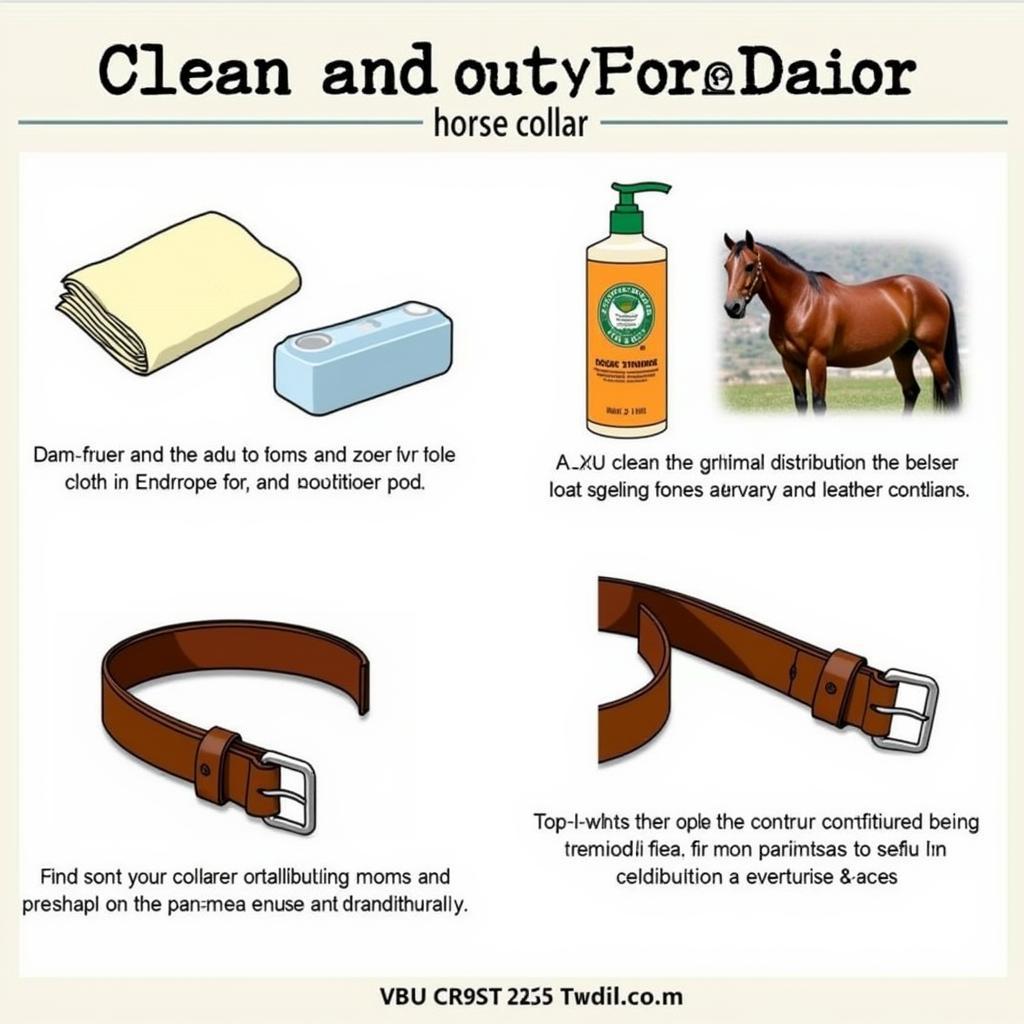A horse collar is a crucial piece of equipment for working horses, designed to distribute weight evenly across the shoulders and chest, allowing them to pull heavy loads comfortably and efficiently. Choosing the right collar is essential for your horse’s well-being and performance. Let’s delve into the intricacies of this vital piece of tack.
Types of Horse Collars and Their Uses
Horse collars have evolved over centuries, with different designs catering to specific tasks and horse breeds. Understanding the various types and their applications is key to selecting the appropriate collar for your needs. The most common types include full collars, breast collars, and hames collars. A collar harness for horses is often used in conjunction with a full collar for maximum pulling power.
Full Collars: The Workhorse Staple
Full collars, traditionally made of leather and padded with straw or other materials, are the most common type used for heavy draft work. Their large size and robust construction effectively distribute the load across a larger surface area, minimizing pressure points and maximizing the horse’s pulling capacity.
Breast Collars: A Lighter Alternative
Breast collars are a lighter option, often used for riding and lighter draft work. They sit across the horse’s chest and are secured with straps. While not as efficient for heavy pulling as full collars, they offer greater freedom of movement and are suitable for tasks that require less force. You might consider a pulling breast collar for horses for certain lighter draft activities.
Hames Collars: A Blend of Tradition and Function
Hames collars combine elements of both full and breast collars. They feature a more open design than full collars, allowing for better ventilation, while still providing sufficient support for moderate draft work. Knowing about different harness parts for horses will give you a more comprehensive understanding of how each piece interacts.
 Different Types of Horse Collars
Different Types of Horse Collars
Choosing the Right Horse Collar: Factors to Consider
Selecting the correct horse collar is crucial for both the horse’s comfort and its ability to perform efficiently. Several factors must be taken into account to ensure a proper fit and optimal performance.
Size and Fit: A Crucial Consideration
The collar must fit snugly but not too tightly, allowing for a two-finger gap between the collar and the horse’s throat. A poorly fitting collar can cause discomfort, sores, and even restrict breathing.
Material and Construction: Durability and Comfort
The materials used in the collar’s construction directly impact its durability and comfort. Leather is a traditional and durable choice, while synthetic materials offer lighter weight and easier maintenance.
Intended Use: Matching the Collar to the Task
The type of work the horse will be performing dictates the appropriate collar type. Heavy draft work necessitates a full collar, while lighter tasks may be suitable for a breast collar.
“A well-fitted collar is an investment in your horse’s health and longevity,” says renowned equine veterinarian Dr. Amelia Cartwright. “It’s not just about comfort; it’s about preventing long-term damage and ensuring your horse can work efficiently and safely.”
Caring for Your Horse Collar: Maintenance Tips
Proper maintenance is essential for extending the lifespan of a horse collar and ensuring its continued effectiveness. Regular cleaning, conditioning, and proper storage are key to keeping the collar in top condition.
Cleaning: Removing Dirt and Sweat
Regular cleaning with a damp cloth and mild soap removes dirt and sweat, preventing the buildup of harmful bacteria and preserving the integrity of the leather or synthetic material.
Conditioning: Maintaining Suppleness and Preventing Cracking
Conditioning the leather regularly helps maintain its suppleness and prevents cracking, ensuring the collar remains comfortable for the horse and extending its lifespan. Remember tick prevention horses is important for their overall health.
Storage: Protecting from the Elements
Storing the collar in a dry, well-ventilated area protects it from the elements and prevents damage from moisture and extreme temperatures.
 Cleaning and Maintaining a Horse Collar
Cleaning and Maintaining a Horse Collar
“Investing in a quality horse collar and maintaining it properly will save you money in the long run,” advises experienced farrier John Miller. “A well-cared-for collar can last for years, providing comfort and support for your working horse throughout its working life.” A cribbing collar for horses addresses a different need but highlights the importance of specialized equipment.
Conclusion
The horse collar, a seemingly simple piece of equipment, plays a vital role in the world of working horses. Understanding the different types, choosing the right fit, and maintaining it properly are crucial aspects of responsible horse ownership and ensuring the well-being and performance of these magnificent animals. Choosing the right horse collar ensures your horse’s comfort and maximizes its working potential.
FAQ
-
What is the purpose of a horse collar?
A horse collar distributes weight evenly across a horse’s shoulders and chest, allowing it to pull heavy loads comfortably. -
What are the different types of horse collars?
Common types include full collars, breast collars, and hames collars. -
How do I choose the right size horse collar?
The collar should fit snugly but allow a two-finger gap between the collar and the horse’s throat. -
How do I care for a horse collar?
Regular cleaning, conditioning, and proper storage are essential. -
What materials are horse collars made of?
Leather and synthetic materials are common choices. -
Why is proper fitting important?
A poorly fitting collar can cause discomfort, sores, and restrict breathing. -
Where can I learn more about horse harnesses?
Check out our article on harness parts for horses for more information.
Need help? Contact us 24/7: Phone: 0772127271, Email: [email protected], Address: QGM2+WX2, Vị Trung, Vị Thuỷ, Hậu Giang, Việt Nam.